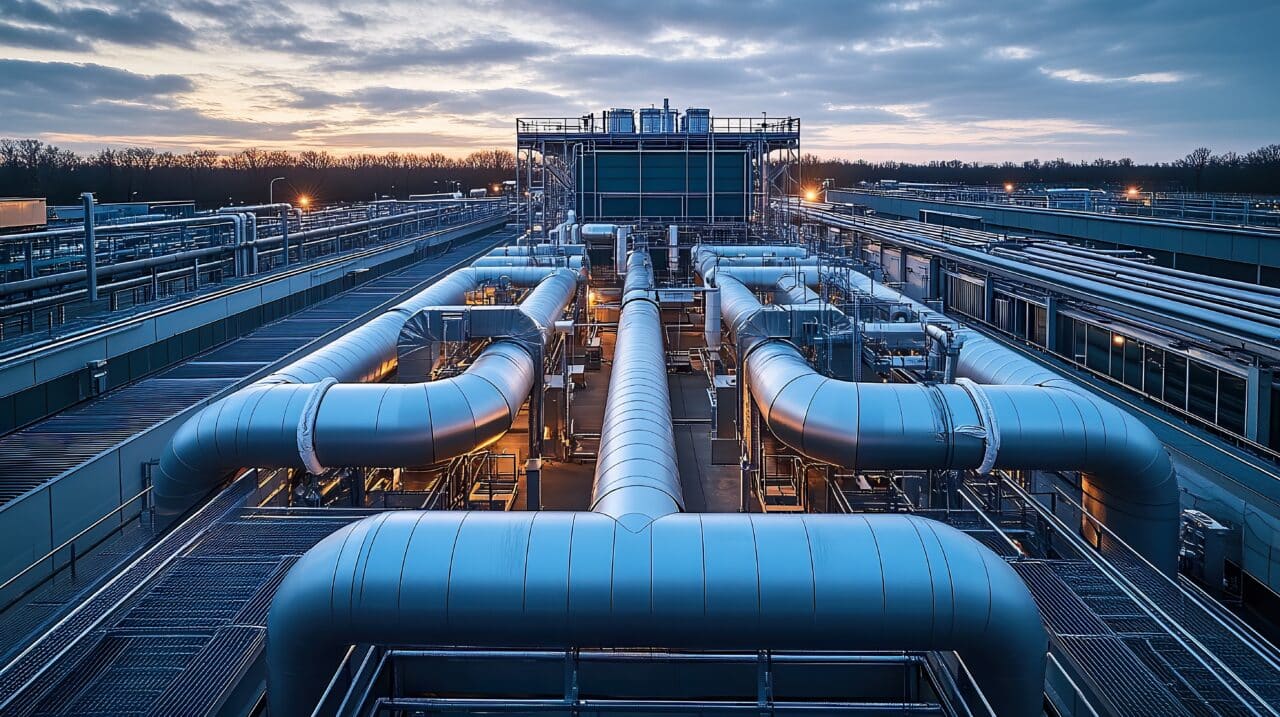A conveyor stalls, a sensor fails, and then a technician calls out sick from exposure near the weld zone. Now your shift is behind, QA reports are flagged, and you’re left explaining another preventable delay.
This is what poor ventilation costs: Downtime, equipment failures, compliance issues, and a workforce that’s harder to retain.
Industrial ventilation systems exist to stop that spiral.
We help Southeast facilities design and maintain ventilation systems that keep air clean, uptime steady, and compliance in check. Here’s how the right system protects your people, equipment, and production.
Downtime Drivers Caused by Poor Air Quality
Unplanned downtime isn’t always caused by aging equipment or operator error. In many facilities, the real culprit is the air. Poor indoor air quality can damage machinery, trigger safety protocols, and strain your workforce … all while productivity takes the hit.
According to recent industry data, 82% of manufacturers reported unplanned downtime within a three-year span. Each event averaged $2 million in losses, or $260,000 per hour. For many operations, that’s the difference between meeting quota and missing a shipment.
Here’s where ventilation problems show up first:
Equipment Contamination & Overheating
Fine particulate buildup from grinding, cutting, or sanding settles on motor windings, sensors, and circuit boards. Over time, this insulation traps heat, causing premature failures or inconsistent performance.
Ever replaced a motor or relay twice in one quarter? Poor air quality may be the reason.
Corrosive & Combustible Fumes
Chemical vapors from cleaning, painting, or process gases smell strong, and they also corrode internal circuitry and wiring (especially in humid or enclosed zones).
In hazardous locations, these fumes can trigger forced shutdowns when detectors or air samples spike above the threshold.
Worker Illness & Absenteeism
Respiratory irritation, fatigue, and chronic coughing are common in weld zones, sanding booths, and mixing areas without source capture. When operators take more breaks (or more sick days), output drops, and scheduling gets tight. One missed shift can snowball into overtime and missed targets.
Regulatory & Safety Shutdowns
OSHA (Occupational Safety and Health Administration) air quality citations, failed sensor readings, or gas monitor alarms often force production lines to stop. These shutdowns cost time, slow deliveries, and pull safety staff off other priorities to investigate and document every incident.
Product Quality Defects
Airborne dust, mist, or fibers that settle on open packaging lines, coating booths, or clean assembly zones can compromise product quality. That leads to rework, scrap, or recalls that hit your bottom line.
If you’re seeing patterns in breakdowns, complaints, or callouts, it may be time to evaluate how your manufacturing ventilation system design could maximize building uptime.
How Industrial Ventilation Systems Prevent These Issues
The right industrial ventilation system is designed for your processes, not pulled from a template. Here’s how it prevents the kinds of issues that slow down production and overload your maintenance calendar.
Source Capture Design
General dilution won’t cut it in areas with concentrated emissions. If your paint booth exhaust hood is too small or misaligned, overspray builds up on conveyor rollers and actuator arms, guaranteeing a shutdown when the film gums up a limit switch.
Local exhaust hoods positioned 6-12 inches from the source, with adequate face velocity, are essential in high-particulate areas such as TIG welding stations, solder rework benches, and mixing tanks, where vapors displace oxygen.
When was the last time you mapped fume behavior with tracer smoke or measured hood capture velocity under real load?
Filtration & Separation Technologies
Filter selection should match your byproduct. A HEPA system may be overkill for coarse wood dust, but it is mandatory in spaces such as pharmaceutical cleanrooms or medical packaging zones. Wet scrubbers excel in aluminum grinding, where dry dust creates spark risk, but are a liability near freeze-sensitive ducts.
If your production includes epoxy resins, metal powders, or flour-based blends, the wrong filter media will clog fast, and that’s what quietly takes your system offline.
We recommend that facilities teams track static pressure trends to catch filter loading early, not after the motor overheats.
Make-Up Air & Airflow Balancing
Negative pressure in a spray room sucks in unfiltered air from dock gaps and restroom vents. That not only ruins your airflow map but also introduces uncontrolled humidity.
For facilities in the South using packaged rooftop A/C units, infiltration leads to coil icing, condensation on controls, and inconsistent temperature zones across your floor.
Make-up air prevents production drift and HVAC wear from constant overcompensation.
Smart Monitoring & Controls
Running fans at full speed around the clock drains energy budgets and shortens bearing life. Variable-frequency drives (VFDs) paired with airflow and pressure sensors can respond to occupancy, time of day, or even filter loading, allowing for more precise control.
When your line is down for changeover or cleaning, the system automatically ramps down. A simple adjustment of your VFD, halving the motor speed, can reduce energy use by up to 75%.
Our Smart Buildings Group can integrate these controls into your existing building automation platform, so you’re not relying on analog gauges or siloed alarms. The goal isn’t just uptime. It’s precision.
Quantifiable Benefits & ROI
A well-designed industrial ventilation system isn’t just a health or safety upgrade. It delivers measurable returns in reduced maintenance costs, better equipment longevity, and fewer interruptions to your production schedule. Here’s where the numbers start adding up.
Reduced Unscheduled Maintenance
Dust on thermal sensors. Vapor buildup around PLC cabinets. Fine debris coating control panels. These are the silent causes of emergency calls, HVAC lockouts, and equipment resets that chew up your maintenance budget.
A properly tuned ventilation system reduces:
- Motor overheating and burnouts
- Conveyor bearing failures
- Shorted sensor wiring and emergency panel resets
Cleaner equipment means fewer repairs and fewer late-shift disruptions.
Extended Equipment Lifespan
Every minute a belt slips due to humidity drift or a clutch fails from surface corrosion, you’re losing both time and equipment life. Proper filtration and airflow balance preserve mechanical integrity by limiting:
- Acidic vapor contact with exposed components
- Abrasive dust on shaft seals and actuators
- Heat traps that degrade insulation or lube cycles
Ventilation keeps your equipment in fighting shape longer.
Improved Worker Productivity
When air quality slips, workers feel it first. Headaches in the mix tank area, persistent coughs near solvent stations, or a jump in sick calls from high-exposure bays all point to poor capture or filtration. Cleaner air means:
- Fewer unscheduled breaks
- Lower absenteeism
- Higher morale and retention
Energy Savings
Over-ventilating empty zones is like leaving the dock door open with the A/C on. Smart systems with VFDs let you scale airflow based on real-time needs.
As we mentioned earlier, cutting fan speed in half with VFDs can reduce power use by up to 75%. That kind of efficiency makes an immediate impact when your HVAC system no longer has to overcompensate for pressure loss or temperature swings across the building.
Compliance Peace of Mind
Facility compliance shifts depending on which agencies regulate your operations. Some teams answer to OSHA, focusing on air exposure limits and worker safety. Others follow ASHRAE (American Society of Heating, Refrigerating and Air-Conditioning Engineers) guidelines for indoor air quality or NFPA (National Fire Protection Association) standards tied to combustible dust and fire risks.
No matter who’s checking, one fact stays consistent: Citations and shutdowns are expensive.
A modern industrial ventilation system gives your Environmental Health and Safety (EHS) manager data, traceable logs, and confidence walking into any audit.
Implementation Best Practices
Installing a new industrial ventilation system — or optimizing what you already have — starts with understanding the realities on your floor. The systems that deliver long-term ROI are those built around actual site data, flexible infrastructure, and seamless integration.
Here’s how to make that happen.
Conduct a Contaminant & Airflow Audit
Start with measurement, not assumptions. Dust meters, VOC sensors, and airflow hoods help map where concentrations build, how contaminants behave during shifts, and whether capture devices are performing.
If operators complain about haze in the morning or odors near mixing tanks, this audit confirms what your team already suspects and gives you the information to take action.
Design for Future Capacity
Will your line be adding automation within the next 12 months? Will seasonal demand shift production volume? Ventilation systems should support growth, not bottleneck it.
Modular ductwork and scalable collector units enable you to extend coverage without full redesigns later. Undersizing for today’s load will always cost more when tomorrow’s comes early.
Integrate with Building Automation
When airflow, temperature, and pressure data live in one dashboard, you get faster alerts and clearer trends. Our specialists connect VFDs, dampers, and filter pressure sensors into your central system, so you don’t need to rely on local alarms or guesswork.
Establish a Routine Maintenance Schedule
Even the best-designed system needs regular upkeep. We work with customers to build a rotation that includes:
- Quarterly duct inspections for buildup or corrosion
- Scheduled filter swaps before pressure spikes
- Fan and damper calibration during shutdowns
Our team also uses predictive analytics to flag early warning signs, turning reactive maintenance into proactive planning.
Successful Examples of Industrial Ventilation Design and Execution
At Harry’s Fresh Foods, we installed a makeup air unit and exhaust system to manage high-moisture output from kettle cooklines, as part of a $4.7 million mechanical infrastructure upgrade that supports food safety and packaging performance.
For HCA’s Parkridge Medical Center in Chattanooga, we completed a $1.3M chiller tower project under tight operational constraints. Our team phased the work to maintain airflow during critical hospital operations, including surgery schedules and post-op recovery zones.
We’ve also delivered customized ventilation systems for manufacturers, stadiums, and healthcare facilities, each designed around specific load requirements, code compliance, and floor-level realities, like shift volume and equipment placement.
Managing a metal-roof facility with seasonal HVAC strain? Our metal building ventilation guide includes practical tips on duct layout, airflow balancing, and filter rotation tailored to warehouse and production settings.
When uptime matters, design details make all the difference. We make sure your airflow plan performs on day 1 and year 10.
When to Call in a Ventilation Professional
Noticing repeat circuit trips, haze in the air, or a spike in sick leave near high-exposure zones? Planning an expansion or equipment upgrade? These are all signs your current ventilation setup may be misaligned with your production realities.
We’ve been serving industrial, commercial, and healthcare facilities since 1944. Our licensed and insured technicians handle everything from source capture design to smart system integration, with 24/7 service to work around your schedule.
We know what it takes to keep air clean in real-world settings with tight tolerances and strict codes. Schedule a professional ventilation assessment today to catch small problems before they shut down your floor.
Is Your Facility Ready for New OSHA Crackdowns?
Get expert guidance on what’s changing and how to stay compliant. Enter your email to access the full breakdown.
Protect your people and your production.
CALL US NOW AT 615.567.1000

